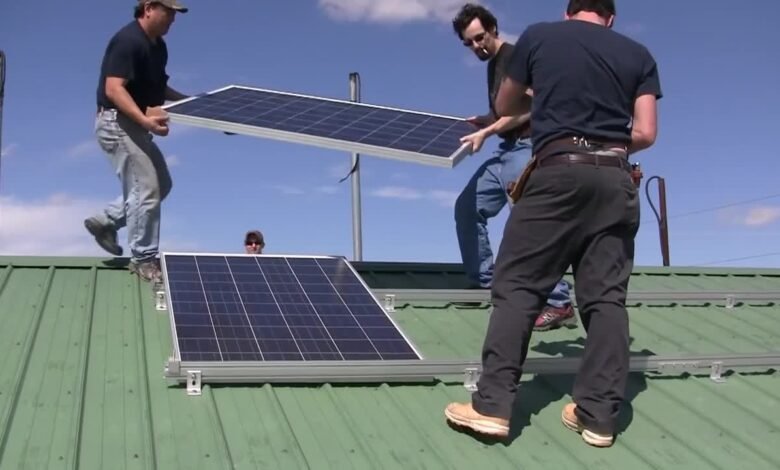Bifacial Solar Panels: A Comprehensive Guide

Introduction to Bifacial Solar Panels
Bifacial solar panels are an innovative technology that can capture sunlight from both sides, increasing energy production efficiency. These panels are designed to harness direct and reflected sunlight from surfaces like the ground or nearby structures. With their dual-sided capabilities, bifacial solar offers the potential to boost solar energy generation while maximizing space utilization significantly.

What are Bifacial Solar Panels?
Bifacial solar panels are cutting-edge photovoltaic modules engineered to harvest sunlight from both their front and rear surfaces, resulting in higher efficiency compared to conventional single-sided panels. These panels can harness direct sunlight and reflected light, often from surfaces like the ground or adjacent structures. This unique two-sided design increases energy output, making bifacial solar a promising solution for enhancing solar energy generation.

How Do They Differ from Monofacial Panels?
Traditional monofacial solar panels only absorb sunlight from their top side. Bifacial panels, on the other hand, leverage the sunlight that reflects off surfaces beneath them to enhance energy production. Picture a sunflower following the sun; now imagine it drawing energy from the ground below. That’s the magic of bifacial panels!

Advantages of Bifacial Solar Panels
Bifacial solar panels capture sunlight from both sides, significantly increasing energy generation by reflecting sunlight off surfaces such as the ground or nearby structures. Their enhanced efficiency makes bifacial panels a cost-effective choice for solar installations, as they produce more electricity per square meter compared to traditional monofacial panels.

Increased Energy Yield
The obvious benefit? More energy! Bifacial panels can produce up to 30% more energy than monofacial panels, depending on their surroundings. Consider enjoying two slices of your favorite cake rather than just one. What person wouldn’t desire that?

Durability and Longevity
With technological advancements, bifacial panels tend to have a longer lifespan and more excellent resistance to environmental factors. It’s like building a house with bricks instead of straw; it lasts longer!

Aesthetic Appeal
With their sleek design and translucent appearance, bifacial panels can seamlessly blend into building designs, making them an attractive option for modern architecture. Remember those excellent transparent phones from the 90s? It’s like that but for solar panels!

How Bifacial Panels Work
Bifacial solar works by capturing sunlight from both their front and rear surfaces. When sunlight strikes the front side, it generates electricity through photovoltaic cells, as in traditional panels. Simultaneously, light that passes through or is reflected onto the rear side is also converted into electricity, increasing overall energy output.

The Role of Albedo
“Albedo” might sound like a fancy term, but it’s just the measure of how much sunlight a surface reflects. Bifacial panels thrive in high albedo environments, where surfaces like white roofs or light-colored grounds bounce back sunlight.

Sunlight Reflection and Absorption
As sunlight hits the ground, a portion of it reflects. Bifacial panels grab this bounced-back energy, giving them a dual power source. It’s like collecting rainwater from the sky and puddles on the ground!

Limitations and Considerations
Bifacial solar requires appropriate ground conditions or reflective surfaces beneath them to maximize their efficiency, so site selection and preparation are critical considerations. Dust, dirt, or shading on the rear side of bifacial panels can reduce their effectiveness, necessitating regular cleaning and maintenance to ensure optimal performance.

Installation Considerations
While bifacial panels offer more energy, their installation requires more care. They need an optimal distance from the ground and angled correctly to maximize their efficiency. Think of it as setting up a satellite dish; positioning is critical!

Cost Implications
Due to their advanced technology, bifacial panels can initially come with a heftier price tag. However, their increased energy output can lead to quicker returns on investment. It’s like paying more for a hybrid car – the fuel savings quickly add up!

Real-world Applications
Bifacial solar are commonly used in commercial solar farms, where they can capture reflected sunlight from the ground, increasing energy production and revenue. They are also employed in urban environments, integrated into building facades or noise barriers, effectively utilizing both direct and reflected sunlight to generate electricity in limited space.

Residential Uses
Bifacial panels can be a game-changer for homeowners seeking to maximize energy production in limited spaces. It’s like having a compact car with the power of an SUV!
Commercial and Utility-Scale Projects
For larger projects, the increased efficiency of bifacial panels translates to significant cost savings over time. Imagine running a business where every product sold brings in twice the profit!

Conclusion
Bifacial solar panels, with their dual-sided energy capture, present a revolutionary approach to solar energy generation. Whether you want to power a home or a large-scale project, they offer a promising avenue for sustainable energy solutions. Ready to soak up the sun from all angles?
FAQs of Bifacial Solar Panels: A Comprehensive Guide
How do Bifacial Solar Panels differ from traditional panels?
Traditional solar panels have a backing that prevents light from passing through, capturing sunlight only from the front side. In contrast, bifacial solar panels have a transparent back layer, allowing them to generate power from both sides. This design increases their efficiency by capturing reflected sunlight from surfaces like rooftops, ground, or other nearby structures.
What are the advantages of using Bifacial Solar Panels?
Bifacial solar panels offer several benefits: Enhanced Power Output: Due to their two-faced design, they can harness more power, yielding an energy gain of 5-20% compared to conventional panels. Robustness: Typically crafted from top-tier materials, they can endure harsh environmental challenges. Compact Power Generation: They can deliver a higher power yield within the same footprint, ideal for areas with restricted space for installation.
Are Bifacial Solar Panels more expensive than traditional ones?
Though bifacial solar panels have a steeper initial cost compared to regular panels, their superior energy production often leads to a quicker payback period. The increased performance can compensate for the upfront expense over the duration, rendering them a more economically viable option in the extended run.
Where are Bifacial Solar Panels best suited for installation?
Bifacial solar panels are adaptable and can be put in a variety of settings. They are, however, instrumental in regions with high albedo (reflectivity), such as white rooftops, sandy plains, or snow-covered terrains. The reflected sunlight from these surfaces maximizes the panels' energy production.
Bifacial Solar Panels: A Comprehensive GuideHow Do You Like Our Post
0






